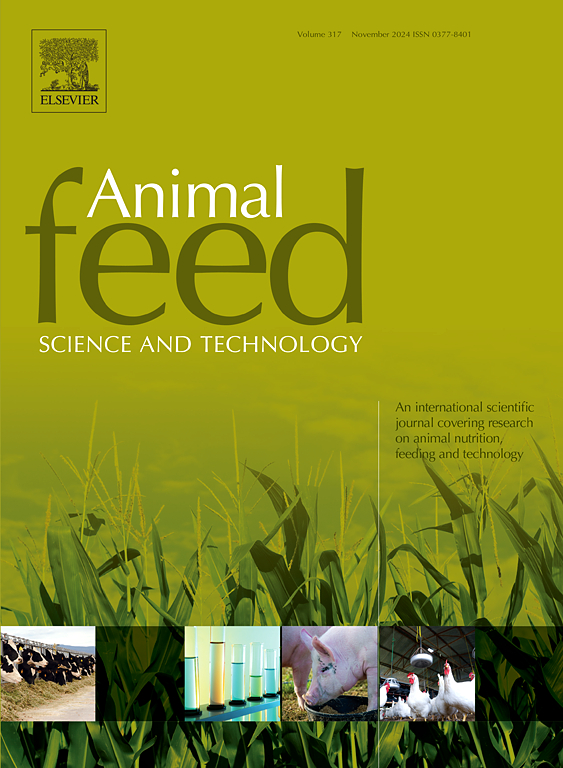Supplementing sow diets with docosahexaenoic acid alters fatty acid composition of sow blood and milk
IF 2.5
2区 农林科学
Q1 AGRICULTURE, DAIRY & ANIMAL SCIENCE
引用次数: 0
Abstract
The objective of this study was to test the effect of supplementing sows with docosahexaenoic acid (22:6 n-3; DHA) of microalgae origin as an in-feed additive on sow and litter parameters, milk yield and composition, plasma fatty acid (FA) composition, plasma cytokines, and fecal microbiota of sows and piglets. The DHA were supplemented (50 mg/kg feed) from farrowing of the previous litter and until weaning of the next litter (n = 248 sows). Milk samples were collected at d 6 and 17, and blood samples from jugular vein at d 17 of the lactation. The DHA concentration in milk and plasma was (P < 0.05) greater for DHA supplemented sows. Milk FA composition showed palmitoleic acid (C16:1 n-7; P < 0.05) and gondoic acid (C20:1 n-9; P < 0.05) were greater in the control compared to the DHA supplemented group. Plasma FA composition showed arachidic acid (C20:0) was (P < 0.05) greater in the DHA fed sows compared with the control sows. There was no effect of treatment on sow and litter parameters, and milk concentrations of fat, lactose and protein, whereas sows on the DHA diet had greater concentration of DHA in the milk (P < 0.05). There was no significant difference between treatments in measured concentrations of cytokines. The microbial alpha diversity was similar between sows fed control and DHA diets and between piglets from sows fed control and DHA diets. In conclusion, dietary inclusion of DHA in sow diets during gestation and lactation affected FA composition of sows plasma and milk.
在母猪日粮中添加二十二碳六烯酸可改变母猪血液和乳汁中的脂肪酸组成
本研究的目的是测试在母猪中添加二十二碳六烯酸(22:6 n-3;DHA)对母猪和仔猪产奶量、产奶量和产奶量、血浆脂肪酸(FA)组成、血浆细胞因子和粪便微生物群的影响。从上一窝产仔开始至下一窝产仔断奶(n = 248头母猪),添加DHA(50 mg/kg饲料)。于哺乳期第6、17天采集乳汁,第17天采集颈静脉血样。添加DHA的母猪奶和血浆中DHA浓度显著高于添加DHA的母猪(P <; 0.05)。牛奶FA组成为棕榈油酸(C16:1 n-7;P <; 0.05)和性腺酸(C20:1 n-9;P <; 0.05)高于DHA补充组。血浆FA组成显示,DHA饲喂母猪的花生酸(C20:0)高于对照母猪(P <; 0.05)。处理对母猪和窝仔参数以及乳中脂肪、乳糖和蛋白质的浓度没有影响,而DHA饲粮的母猪乳中DHA浓度更高(P <; 0.05)。细胞因子的测量浓度在不同处理之间没有显著差异。对照组母猪和DHA饲粮之间以及对照组母猪和DHA饲粮的仔猪之间的微生物α多样性相似。综上所述,妊娠期和哺乳期母猪饲粮中添加DHA会影响母猪血浆和乳汁中FA的组成。
本文章由计算机程序翻译,如有差异,请以英文原文为准。
求助全文
约1分钟内获得全文
求助全文
来源期刊

Animal Feed Science and Technology
农林科学-奶制品与动物科学
CiteScore
6.00
自引率
6.20%
发文量
266
审稿时长
3 months
期刊介绍:
Animal Feed Science and Technology is a unique journal publishing scientific papers of international interest focusing on animal feeds and their feeding.
Papers describing research on feed for ruminants and non-ruminants, including poultry, horses, companion animals and aquatic animals, are welcome.
The journal covers the following areas:
Nutritive value of feeds (e.g., assessment, improvement)
Methods of conserving and processing feeds that affect their nutritional value
Agronomic and climatic factors influencing the nutritive value of feeds
Utilization of feeds and the improvement of such
Metabolic, production, reproduction and health responses, as well as potential environmental impacts, of diet inputs and feed technologies (e.g., feeds, feed additives, feed components, mycotoxins)
Mathematical models relating directly to animal-feed interactions
Analytical and experimental methods for feed evaluation
Environmental impacts of feed technologies in animal production.
 求助内容:
求助内容: 应助结果提醒方式:
应助结果提醒方式:


